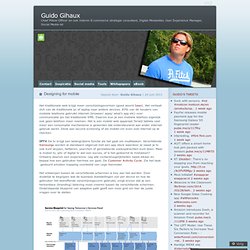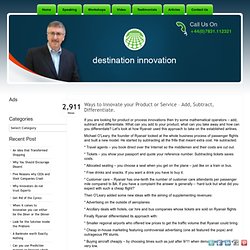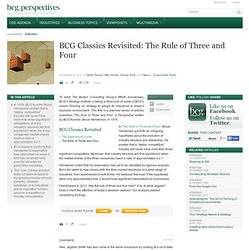

Growth Strategies. Service Product Profit Model - FULL. Pin Customer Activity Cycle on Pinterest. Defining e-Business Projects. By Colm Toolan Some projects are just waiting to be identified!

You might have taken my discussion of search functionality to heart and decided to initiate a project called "Discovery". Maybe your Product Management has decided that it's time to start proactively pushing sensible information out to your customers. [Tip: Don't ever agree to implement any push mechanism, unless you're convinced that the people who are asking for it are properly committed. There have been so many newsletters - both on and offline, that have never gotten beyond Volume 1, Issue 2 - simply because after the initial bout of euphoria nobody had anything to say. Both of these suggestions directly address generic capabilities and can be mapped onto our familiar diagram.
Designing for mobile « .Guido Gihaux. Het traditionele web krijgt meer verschijningsvormen (goed woord Iwan).

Het vertaalt zich van de traditionele pc of laptop naar andere devices. 83% van de houders van mobiele telefoons gebruikt internet (browser/ apps/ what’s app etc) voor communicatie ipv het traditionele SMS. Daarom kun je een mobiele telefoon eigenlijk ook geen telefoon meer noemen. Het is een mobiel web apparaat.Terwijl tablets veel meer een consumptie mechanisme is geworden dat ondersteunend aan ander internet gebruik werkt.
Electronic Commerce Research and Applications - An artist life cycle model for digital media content: Strategies for the Light Web and the Dark Web. Dupont (A): Understanding the Customer's Activity Cycle. Customer Activity Cycle and Business Benefits. By Colm Toolan In our discussion of the Customer Activity Cycle, we mapped the Capabilities required (by different customers types and customers) to support the user doing her "day job".

The final diagram looked like this: Using the list of business benefits prepared in the last step, we can modify this diagram to reflect the benefits that our business will receive from implementing the various capabilities for the customer type or customer in question. For instance, we may think that implementing Discover/Branding will lead to more (or more appropriate) CustomersRetrieve/Product will lead to more (or higher value) OrdersInteract/transactions will increase Customer SatisfactionRetrieve/Other (which needs to be defined and documented) will lead to a reduction in our Costs (of Sale, probably) There's not much additional effort required to take a "guesstimate" of the relative size of the individual benefits.
This classification is used to colour code the diagram: The Customer Activity Cycle. By Colm ToolanThe Brand Awareness Cycle is an important tool for understanding customer behaviour, but it is only part of the equation.

For my way of thinking, the Awareness Cycle on its own, is way too egoistic! It tells us how the customer progresses through a process of discovering our company, getting informed about the details of our products and becoming convinced that we should get his or her business. Which is cool if you're "us", but it's not all you need if you're the customer. Similiar to a CRM (Customer Relationship Management) view of the world, the Awareness Cycle is an "inside-looking-out" view of what's happening. Hiding In Plain Sight - Segmenting and Prospect Profiling. Intelligence 2.0 Keynote Presentation to the 1st China Competitive ... Customer Segmentation Principles.
PDMA Business Model Innovation La. Ways ot innovate - add, subtract, differentiate. If you are looking for product or process innovations then try some mathematical operators – add, subtract and differentiate.

What can you add to your product, what can you take away and how can you differentiate? Let’s look at how Ryanair used this approach to take on the established airlines. Michael O’Leary, the founder of Ryanair looked at the whole business process of passenger flights and built a new model. He started by subtracting all the frills that meant extra cost. He subtracted: * Travel agents – you book direct over the Internet so the middlemen and their costs are cut out. * Tickets – you show your passport and quote your reference number.
. * Allocated seating – you choose a seat when you get on the plane – just like on a train or bus. * Free drinks and snacks. BCG Classics Revisited: The Rule of Three and Four. Strategy BCG Classics Revisited: The Rule of Three and Four Decrease font size Increase font size Tools inShare Related Articles In This Article In 1976, BCG founder Bruce Henderson posited that a “stable, competitive” industry will never have more than three significant competitors, and the industry's structure will find equilibrium when the three companies' market shares reach a ratio of approximately 4:2:1.BCG research confirms that Henderson's observation was valid when he made it and has remained valid over the decades for prescribed industries.This “rule of three and four” does not seem to apply to the growing number of more dynamic, unstable industries, or to industries where regulation hinders genuine competition or industry consolidation.

Where Does Innovation Fit in Your Business Model? - Innovation Leadership Network. Business models are important – they go a large part of the way towards determining how successful your organisation will be.

So here’s a question: where does innovation fit in your business model? There are a number of different ways in which people describe and talk about business models – the common feature is that they describe how an organisation’s activities interact to create and deliver value for their stakeholders. Today, I’ll use the Business Model Canvas version of the business model to illustrate the discussion: The answer to the question of where innovation fits is not very satisfying. The answer is: it depends. So let’s work through where innovation fits in a variety of business models. The three boxes in green are the three categories where your innovation effort and your returns from innovation are in balance.